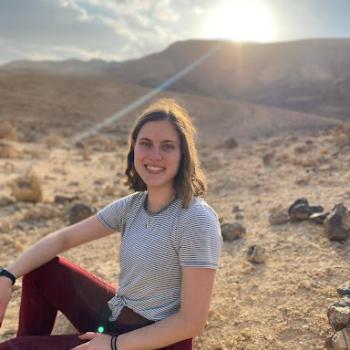By Jayce Koester, Hebrew College rabbinical student
Parashat Pekudei Exodus 38:21-40:38
My spouse and I are currently preparing for a big move in a few short months. This will be our fourth move in four years, and the question “What makes a home?” has been a constant companion amidst the waves of excitement, stress, and trepidation. Building a new home, even with people you already love and are in a deep relationship with, is no small task.
Unsurprisingly, the questions of home and how to build one have been with us since the beginning of our collective story. This week’s Torah portion, Pekudei begins by saying:
אֵ֣לֶּה פְקוּדֵ֤י הַמִּשְׁכָּן֙ מִשְׁכַּ֣ן הָעֵדֻ֔ת
These are accountings of the dwelling-place, the dwelling-place of the testimony (Ex 38:21).
We are entering the end of our time at Sinai, about to face the desert, and we need to finish the work of building G1d’s home amongst the Jewish people. This is a heavy and crucial step, and we cannot navigate the desert without a home for G1d to dwell amongst us. Even in a state of wandering, the question of what makes a home is central.
There are three main steps to the final creation of the Mishkan – each bringing a little wisdom about the process of home-building and -finding. First, the community finishes the component parts and brings them to Moshe, who blesses the people upon their receipt. Second, Moshe builds (and rebuilds) the Mishkan. Finally, the people begin their new journey.
It is Betzalel and Oholiav who are responsible for the building of the Mishkan itself, not Moshe. Using silver and gold sourced from the community, they finish crafting the components for the Mishkan, including clothes for the Levites that will service it. These components are built in accordance with G1d’s instruction to Moshe – but they also represent the unique talents of B’nei Yisrael. Rashi writes about Betzalel creating things that
אֲפִלּוּ דְּבָרִים שֶׁלֹּא אָמַר לוֹ רַבּוֹ, הִסְכִּימָה דַּעְתּוֹ לְמַה שֶּׁנֶּאֱמַר לְמֹשֶׁה בְּסִינַי
Even Moshe didn’t tell him about, [Betzalel’s] intuition [naturally] aligned with what Moshe received at Sinai. (Rashi on Ex. 38:22).
Building this holy home, the Mishkan, takes many hands. While Moshe will play a role in the assembly, the pieces are built by those around him.. Collaboration requires trust, and our most precious homes are often created with the community surrounding us.
In the midst of this, Moshe gives a blessing to the people. Rashi tells us that his blessing is a pasuk from Psalms:
וִיהִ֤י ׀ נֹ֤עַם אֲדֹנָ֥י אֱלֹקינוּ עָ֫לֵ֥ינוּ וּמַעֲשֵׂ֣ה יָ֭דֵינוּ כּוֹנְנָ֥ה עָלֵ֑ינוּ וּֽמַעֲשֵׂ֥ה יָ֝דֵ֗ינוּ כּוֹנְנֵֽהוּ
May the delight of G1d our G1d be upon us – let the labor of our hands be sustained, the labor, oh sustain the work of our hands. (Ps. 90:17)
Even when the work is almost done – the pieces stacked in front of him – Moshe pauses to express gratitude. He is intentionally stepping back and honoring this work, the labour of all their hands together. It can be easy for me to get lost in the logistics of a task. As I read, I took a deep breath here and stepped back, touching into my own well of gratitude.
When the time comes for the materials to be delivered to Moshe, Rashi and Ramban zero in on two interesting details. First, Rashi notices the passive language of הוּקַם הַמִּשְׁכָּן (Shemot 40:17) “The Mishkan was erected.” Why use the passive voice? Rashi teaches that Moshe was so overwhelmbed by the final construction that even as he (Moshe) appeared to be erecting it, it is actually G!d who steps in and errects it G!dself. When faced with the daunting work of home-building, Moshe allows himself to receive support and loosen his grip on the project in front of him. In that space, G1d arrives and is able to help him in its construction.
Second, Ramban notices an oddity in the text – why does G1d instruct Moshe in setting up the Mishkan seven days before he is instructed to actually finish its construction? He answers that perhaps Moshe spends the seven days continually setting up, taking down, and setting up again this new G1d-home. In other words, Moshe spends a whole week practicing building this new home. It is on the decreed eighth day that he finally finishes the home and it becomes a permanent dwelling place. I feel so much empathy with Moshe here, wrestling with the physical structure of G1d’s home. I imagine him just as confused as I, unsure at times where one piece or another goes. But, over time, Moshe practices. When he is ready – then he and G1d can establish the Mishkan together.
All of these steps are needed: the trust, receiving, releasing, and practicing that enable the Israelites to set off. In their transience and wanderings, they bring this home with them on their backs and in their hearts. There was no way to create this divine home by a single hand, by powering through the construction with brute force. This week, I’m leaning into the lessons of Pekudei. Creating a home requires time and practice, gentleness and blessings. May our work of home-finding and making, in whatever shape it takes, be sustained and blessed – even when it is not easy.
Jayce Koester (they/them) is a teacher and ritual-lover in their fourth year in the rabbinical program at Hebrew College. Jayce loves learning Torah with all ages and is an enthusiastic davener, eager Talmud student, and lover of all things that grow (people included). They’re always excited to talk about ritual, science fiction, their two cats, and what they’re cooking this week.














